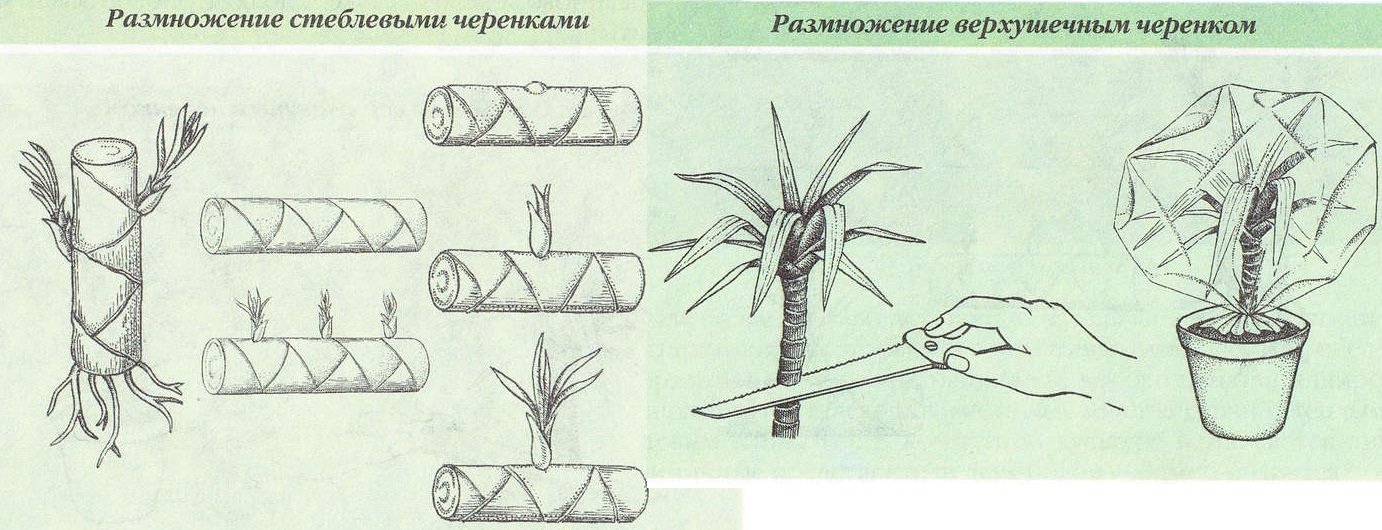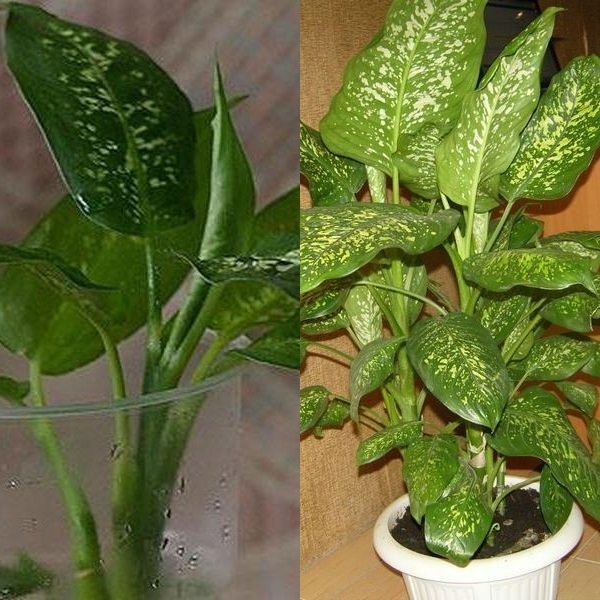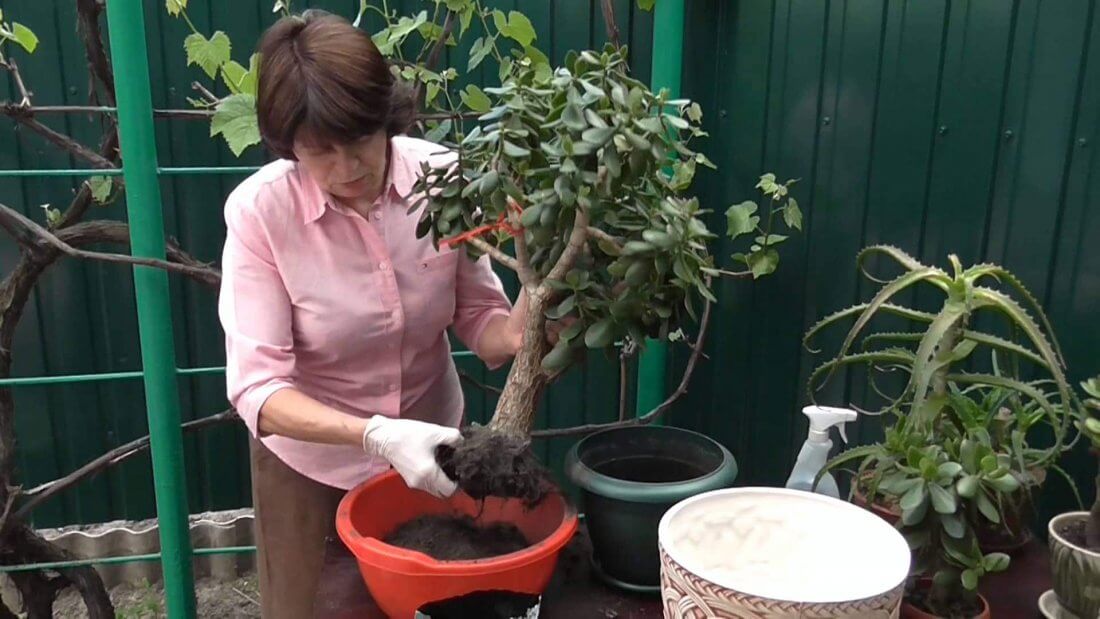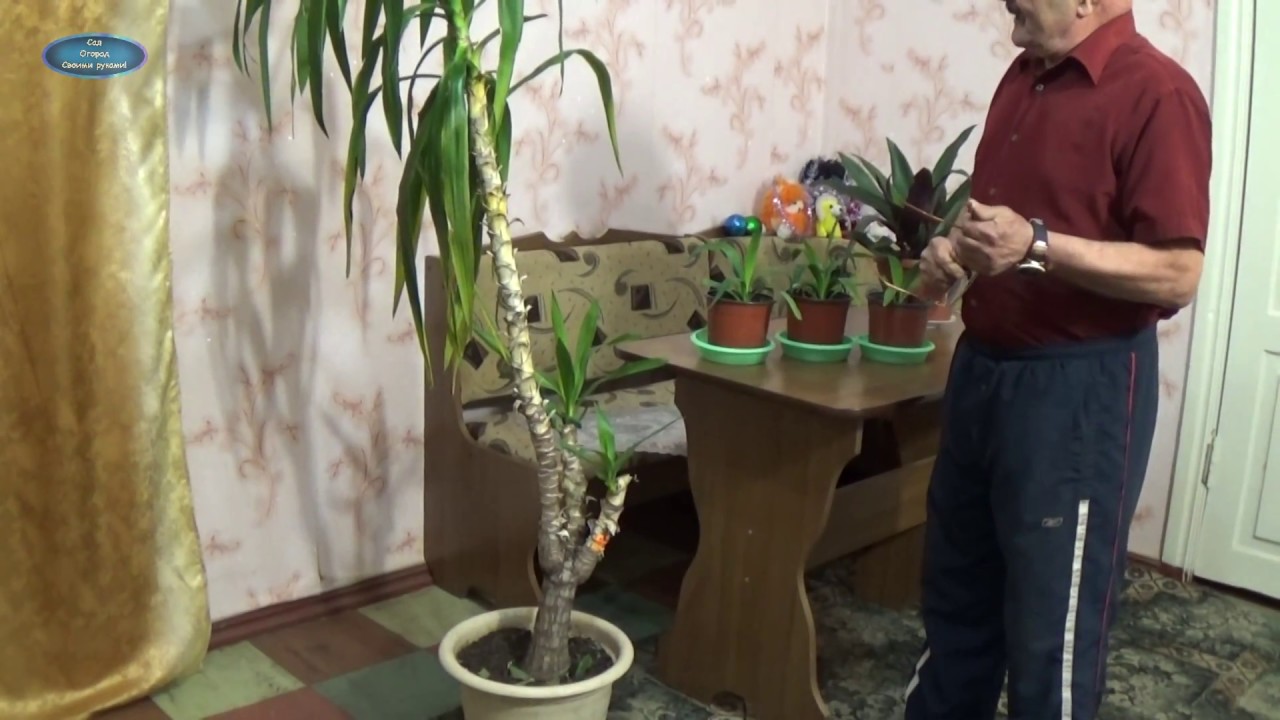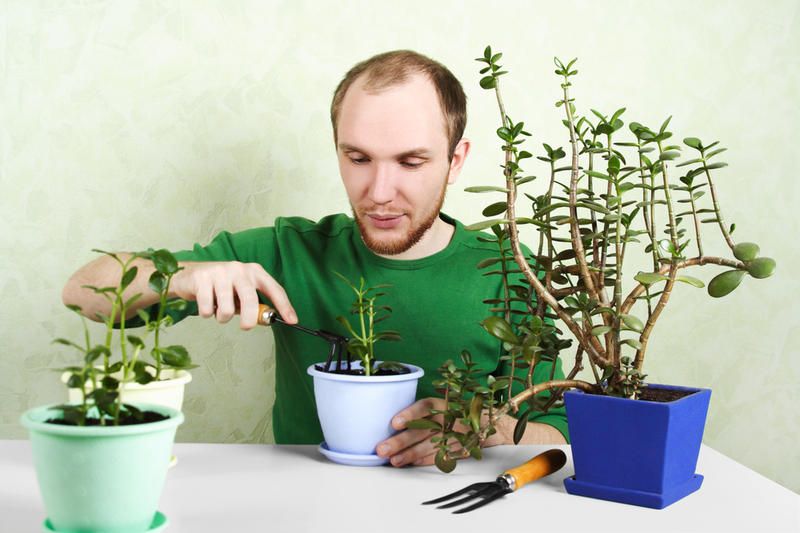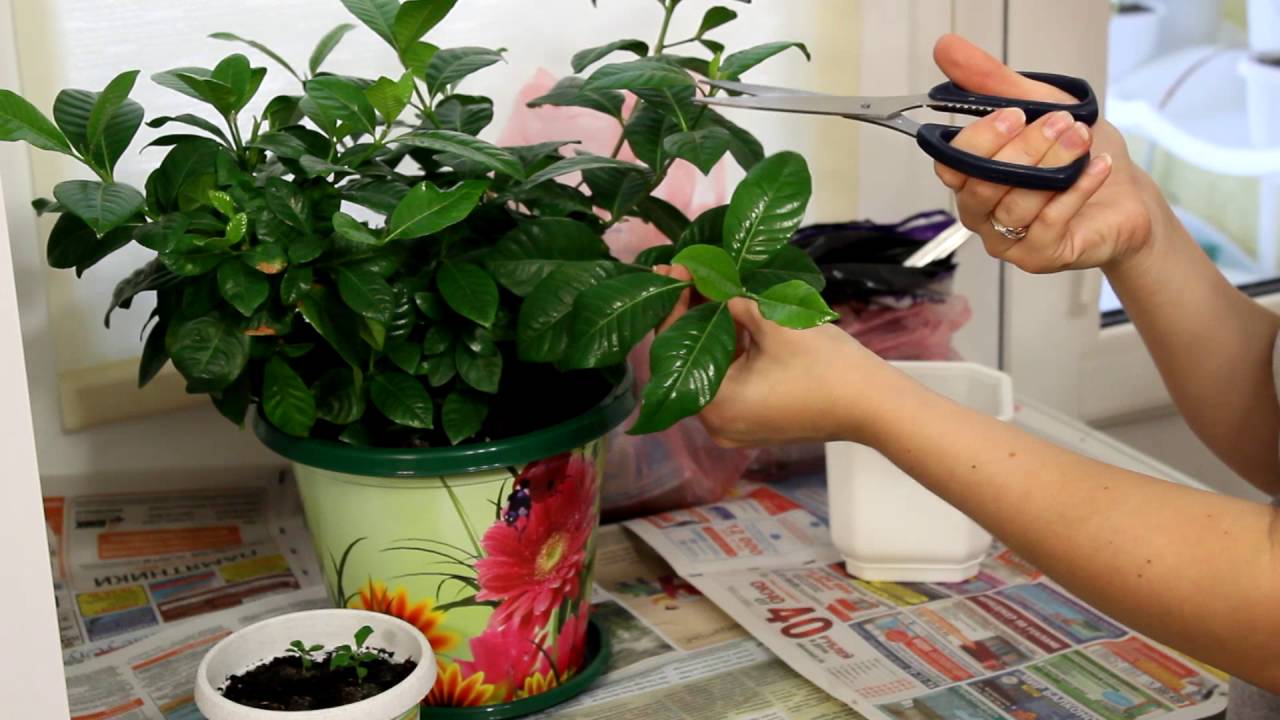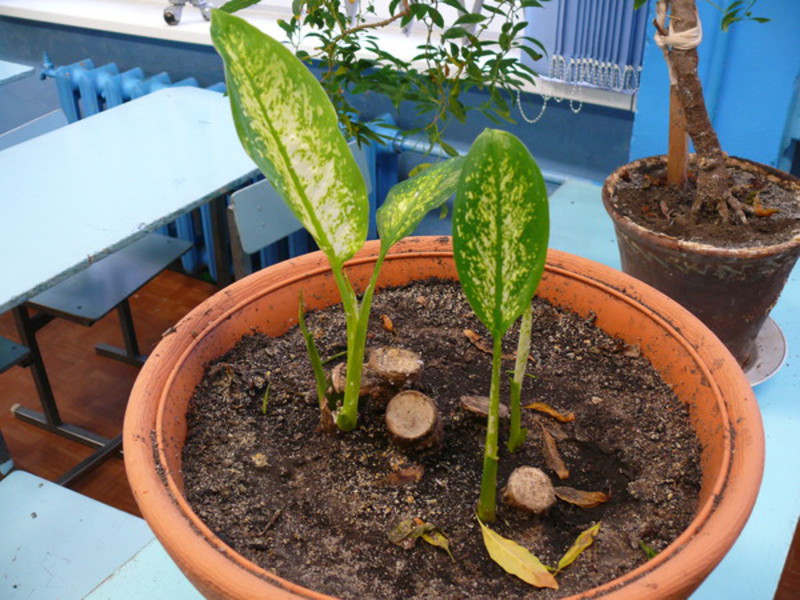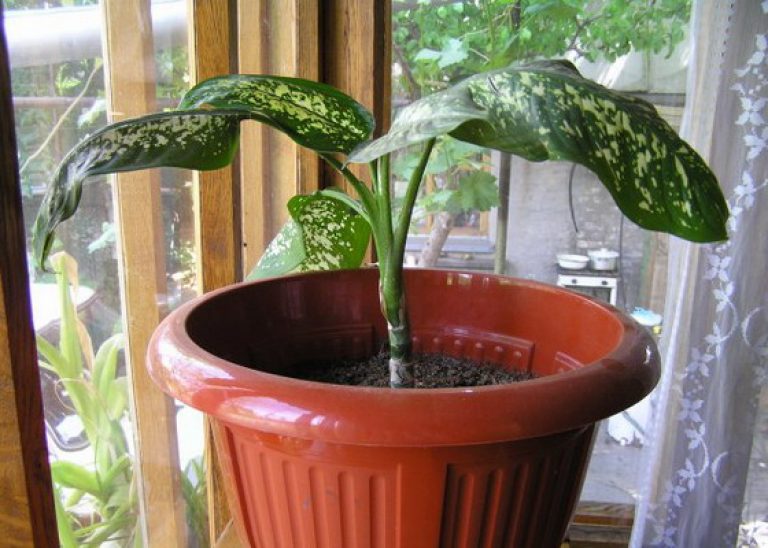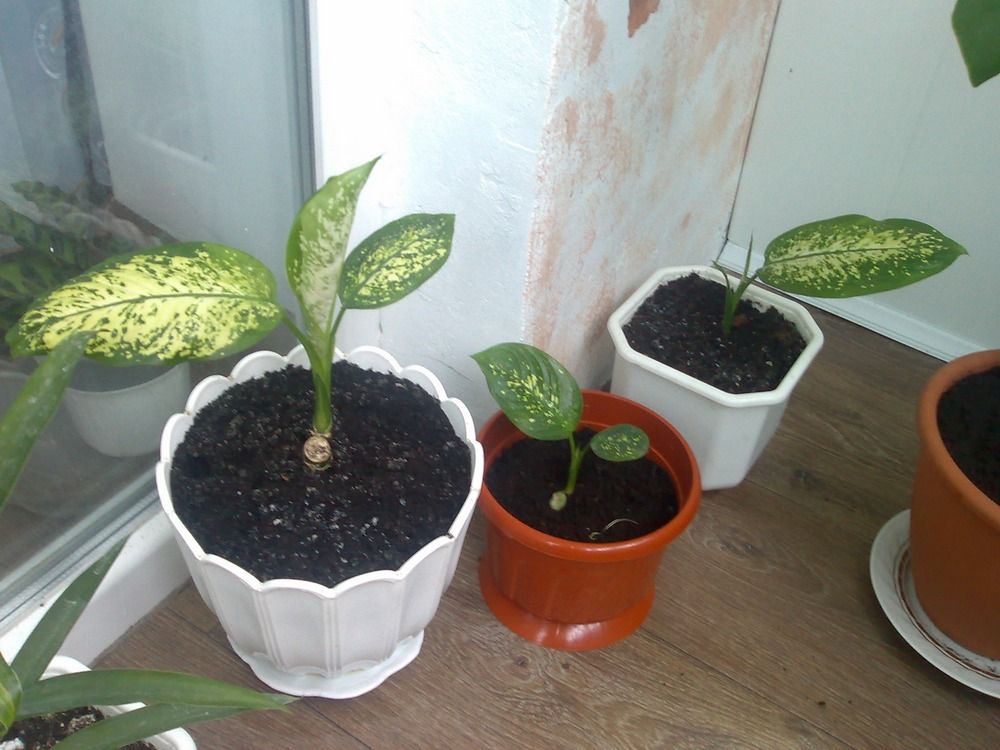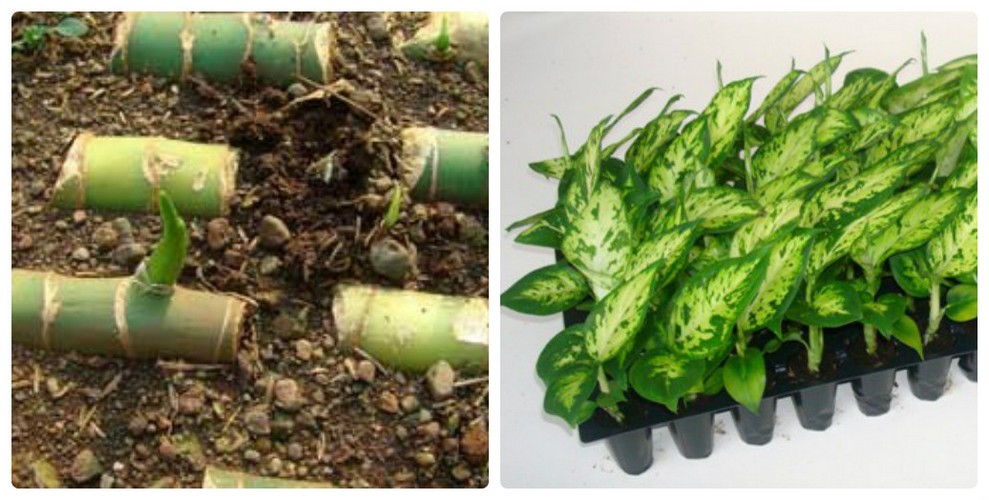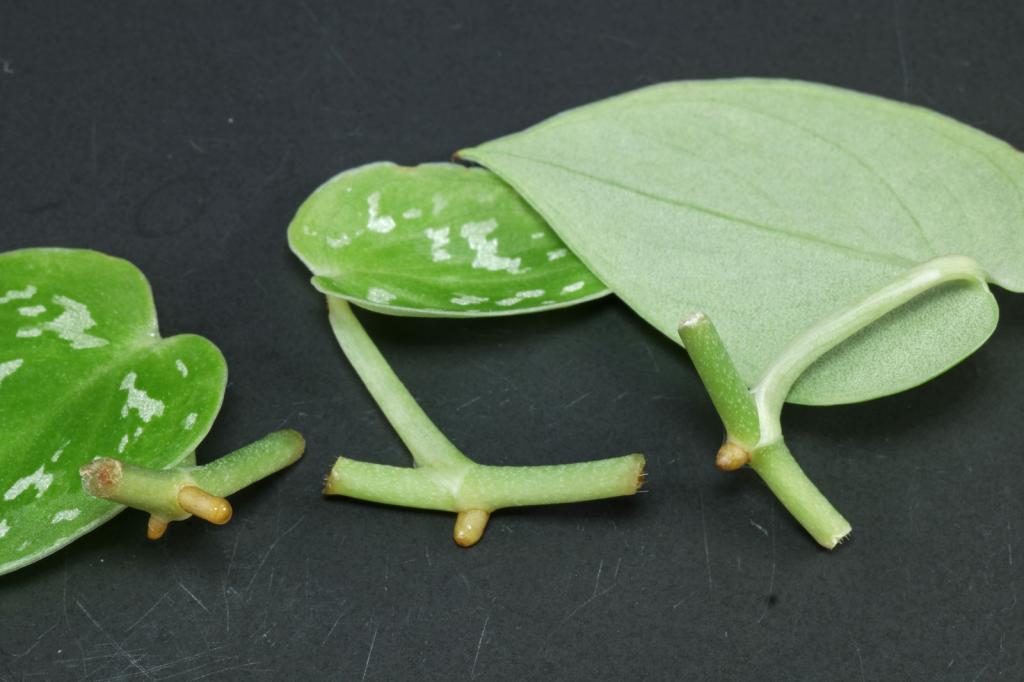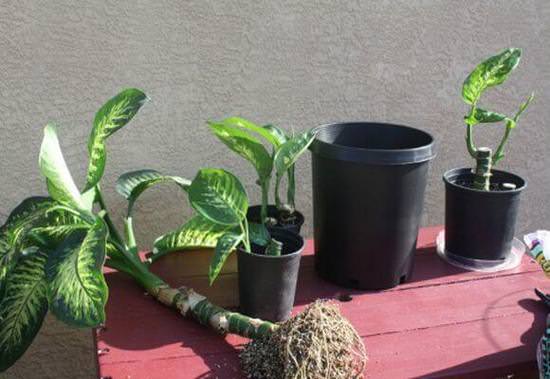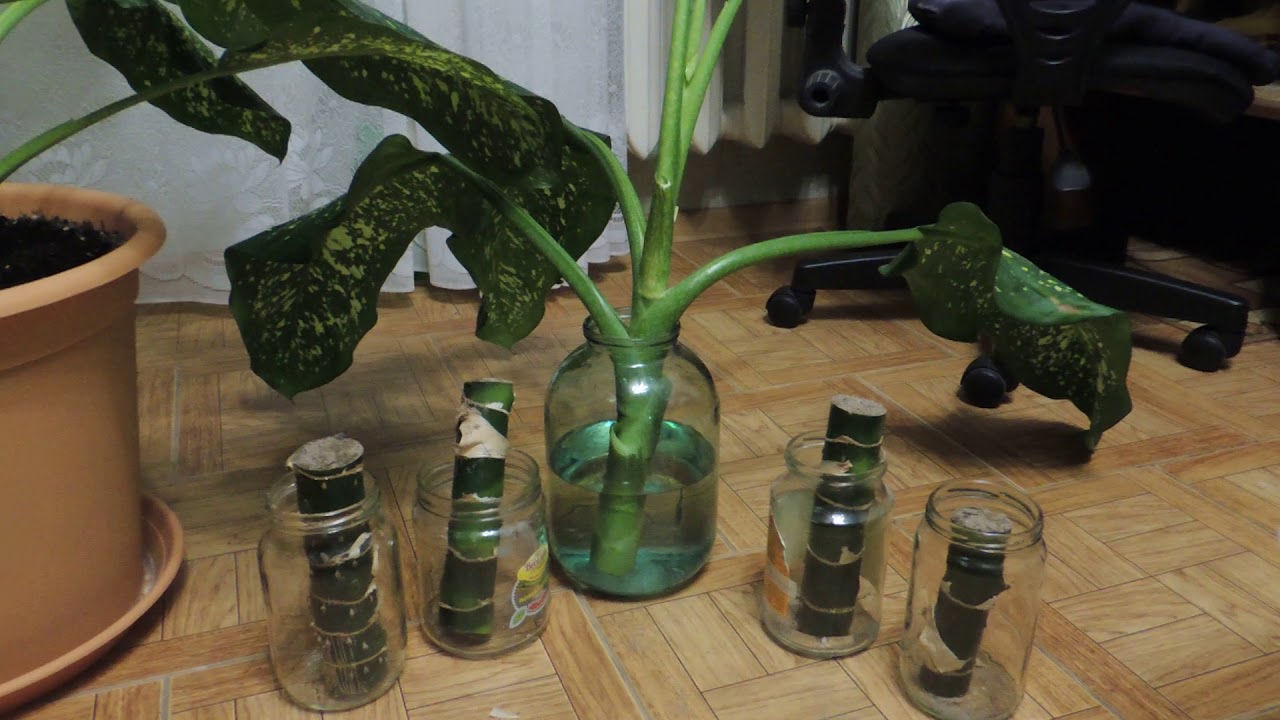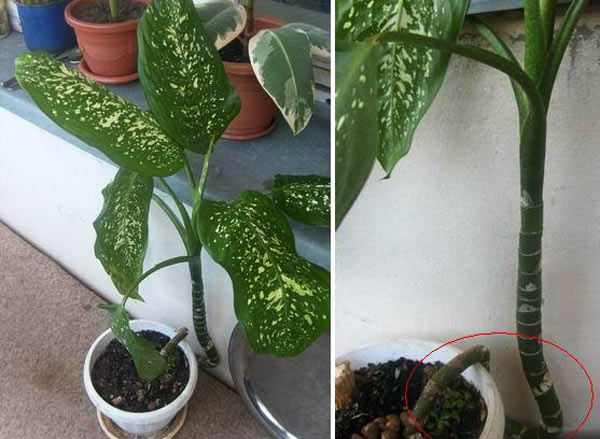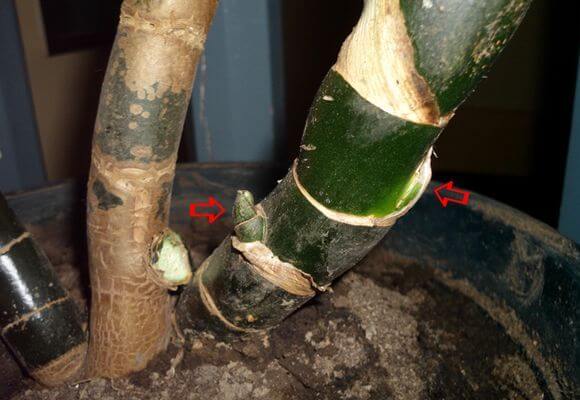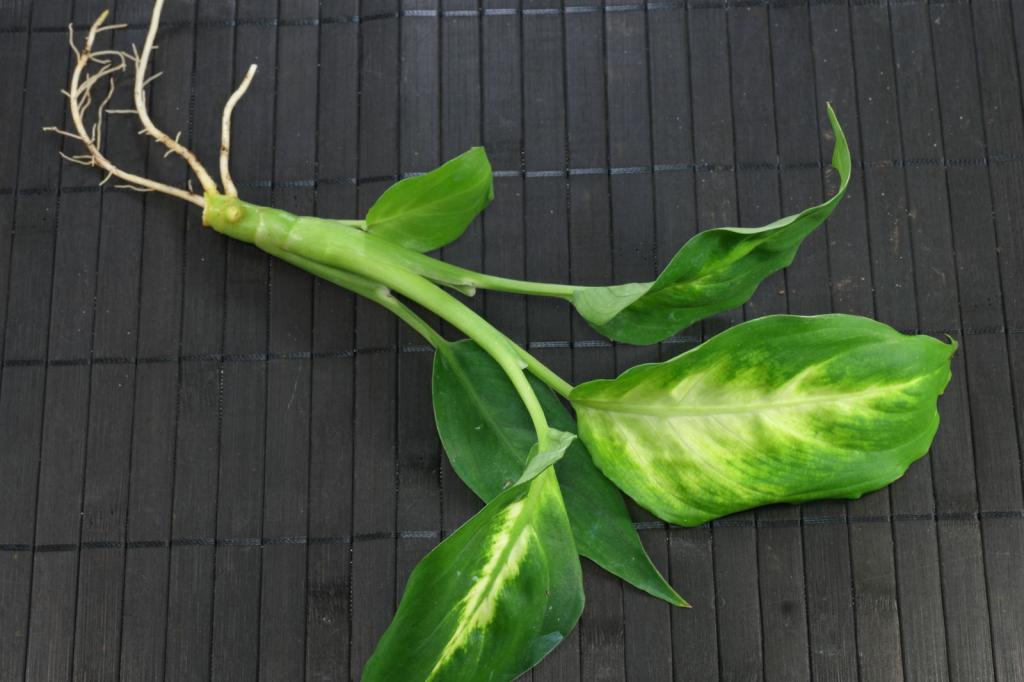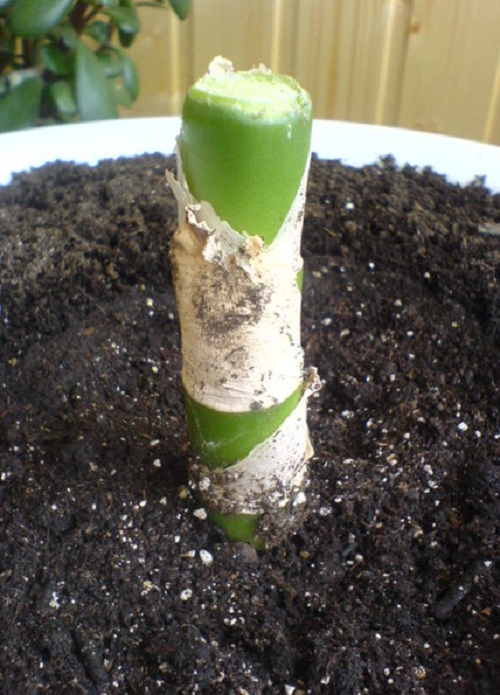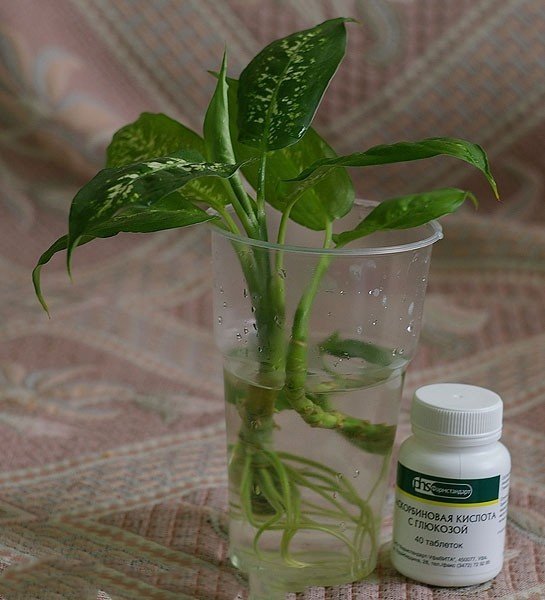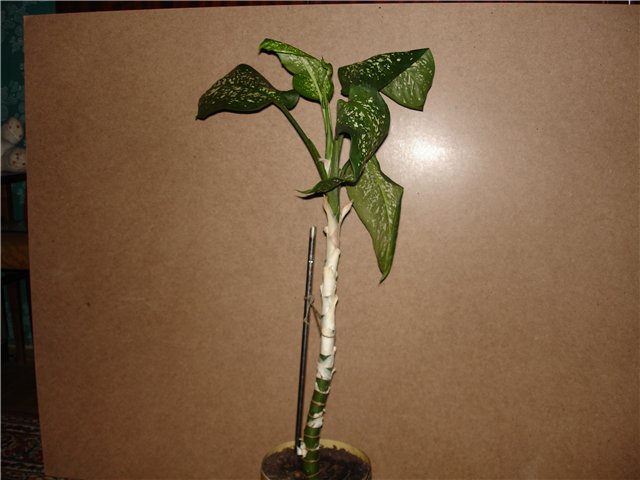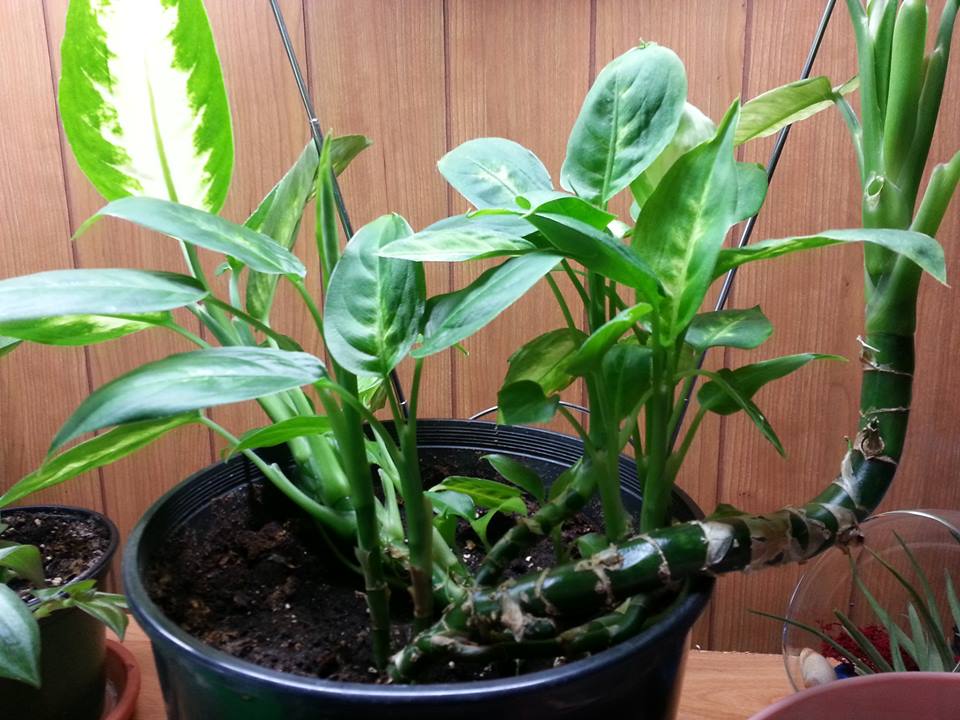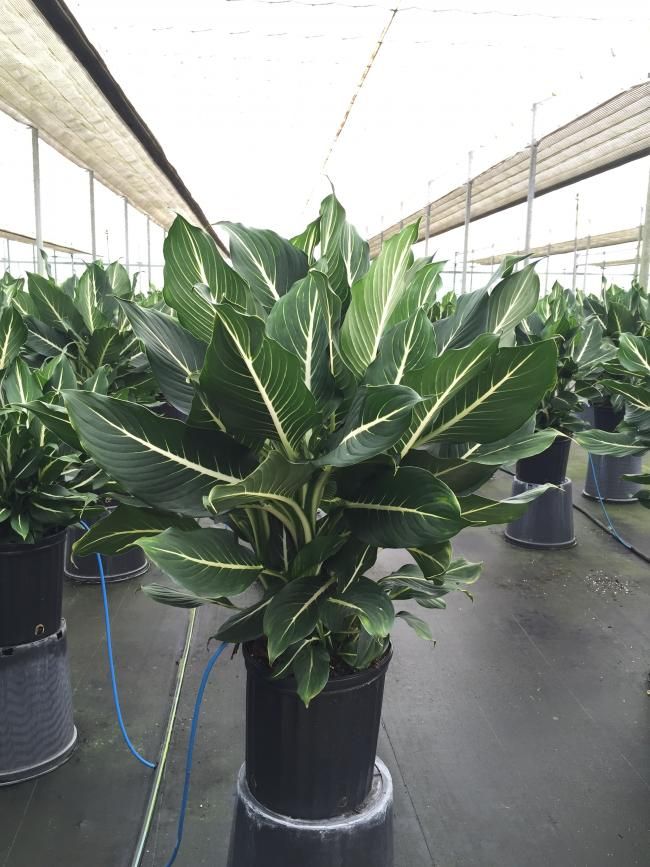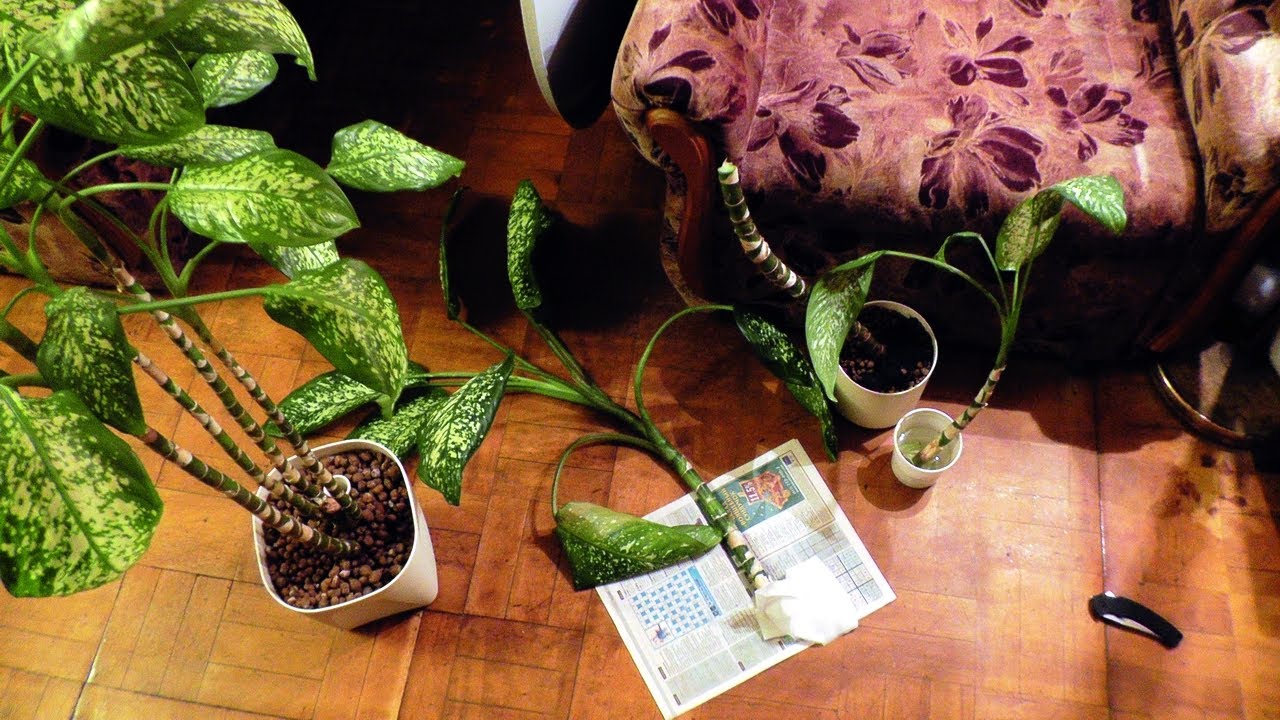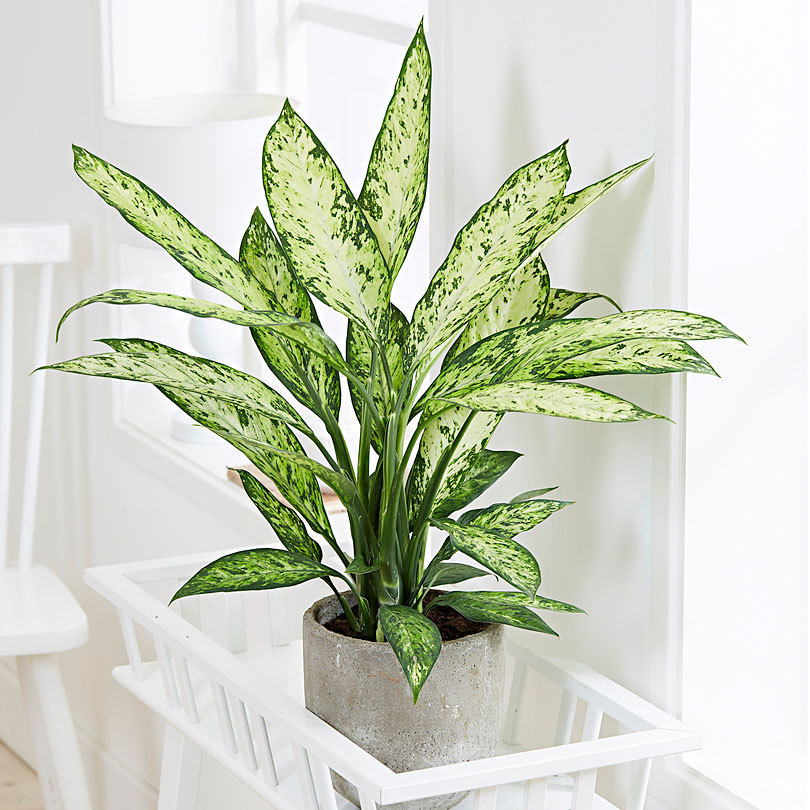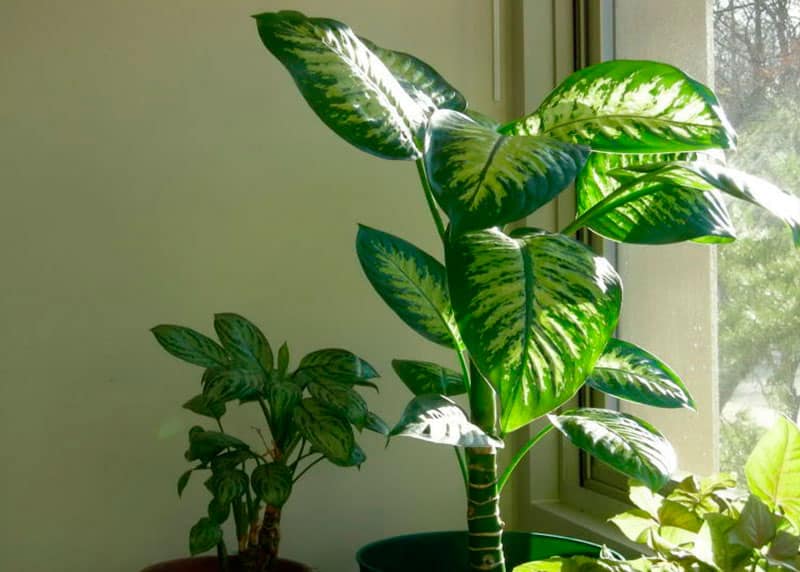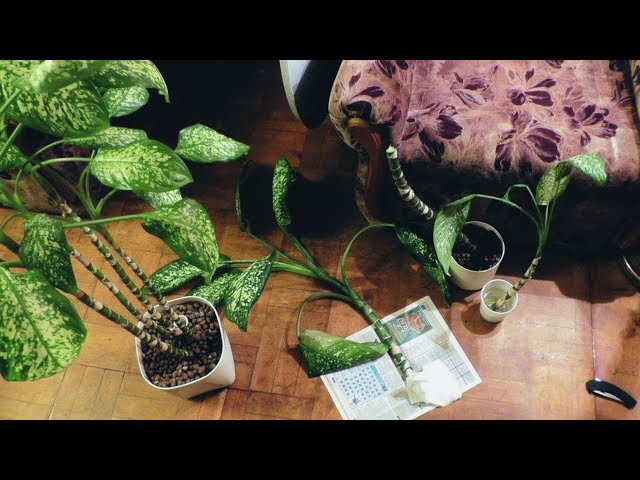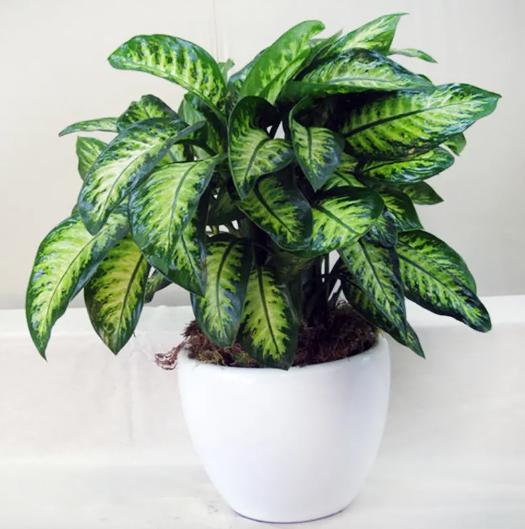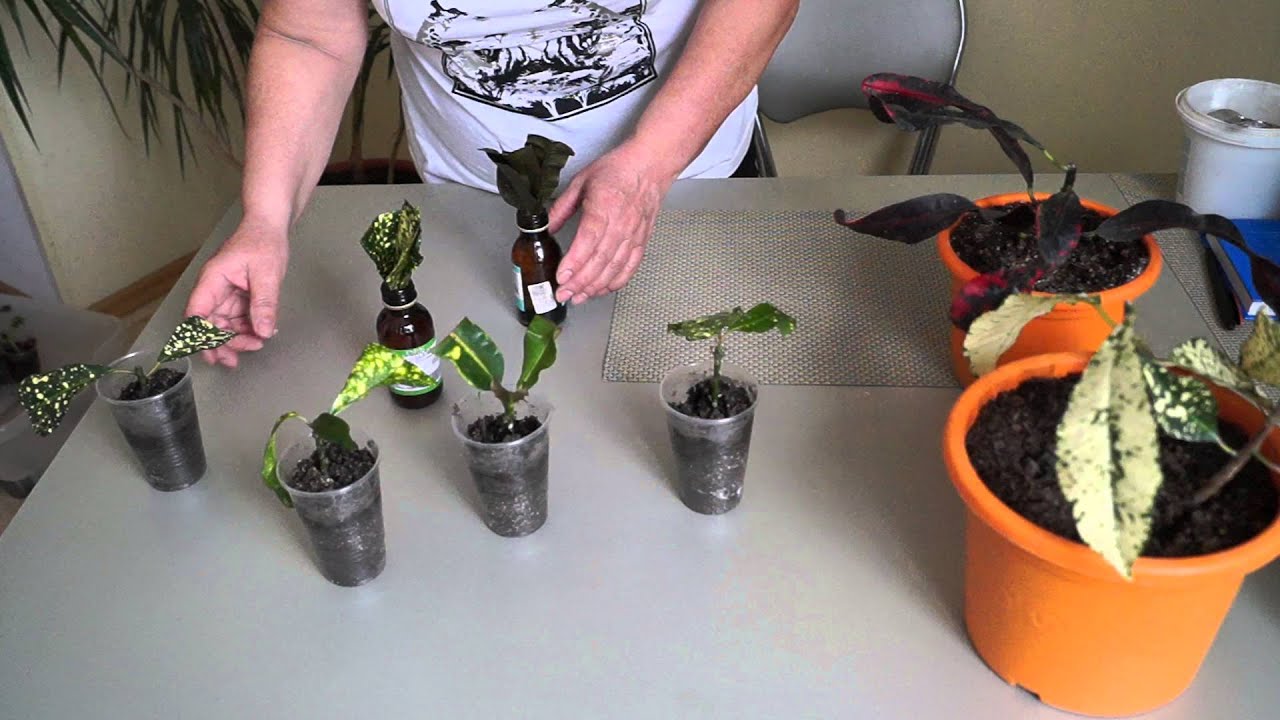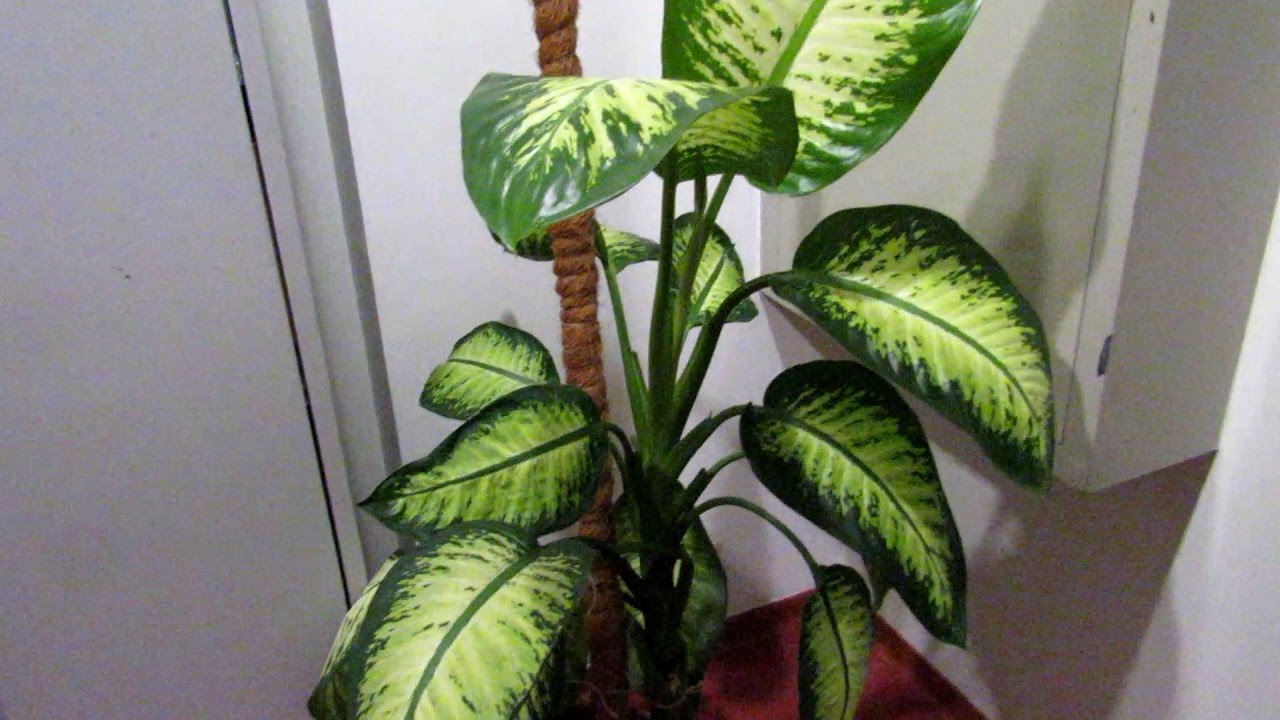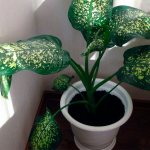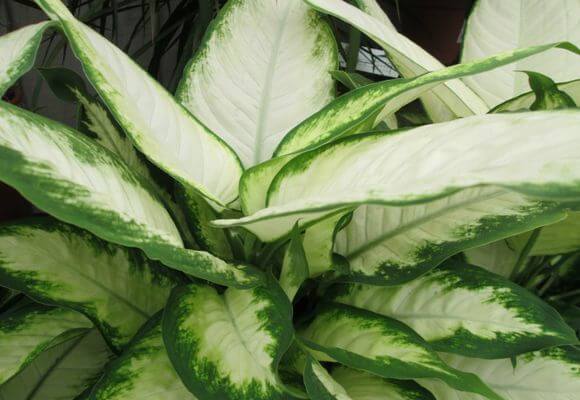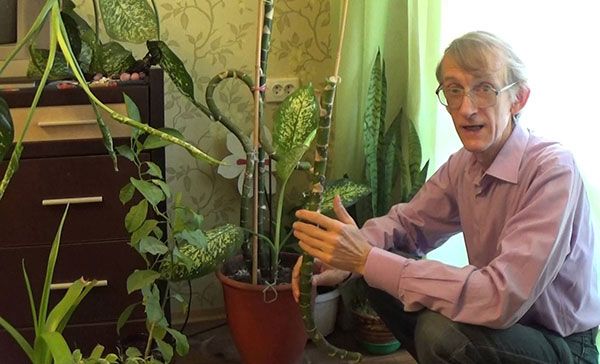Location and lighting
Dieffenbachia needs a lot of light, only then will the unusual color of the leaves remain. The light should be diffused, since under the influence of direct sunlight, burns can appear on the surfaces of the sheet plates.
A window sill located by an east or west window is suitable for location. The southern side is not recommended as a placement, however, you can put a dieffenbachia pot here, protecting it from direct sunlight. For shading, small curtains, blinds or special films that are glued to the glass are used. At a north-facing window, Dieffenbachia does not feel well, because it does not have enough light. If it is not possible to put the plant in another place, arrange additional lighting by installing a special phytolamp or by making a backlight using ordinary fluorescent lamps.
Lack of sunlight negatively affects the condition of the leaves: they become smaller and lose their variegated color. You should not constantly move a flower from one room to another. Dieffenbachia does not tolerate drafts: due to exposure to cold air, the leaves begin to turn yellow and fall off. During airing, the flower must be removed away from the source of the draft, and it is best to take it out of the room. The plant loves fresh air, so in the summer, dieffenbachia is placed on a veranda or balcony, protected from direct sunlight and wind.
Diseases and pests of dieffenbachia
It should be noted that diseases and pests can infest the flower if dieffenbachia care does not meet the requirements. A strong plant itself resists disease. Of course, you can populate insects from a neighboring flower or use the land with live mycelium of the fungus for transplantation, but this only means that the care of the plants on the windowsill is broken.
Signs of fungal diseases are the appearance on the leaves of uncharacteristic spots, stripes, weeping and drying edges of the leaves.
When decaying, the root system cannot provide the plant with food, yellowness appears on the leaves.
Such diseases as:
Anthracosis affects the upper part of the plant. The appearance of dry spots that enlarge and destroy the leaf is the most common manifestation of the disease. Spores can get in with irrigation water. The disease provokes dryness in the room, excessive watering. You can treat it with fungicides and remove the infected parts of the plant. Normalize the containment regime.
Fusarium spreads to the roots and the entire plant. The fungus lives in the soil. Therefore, sterilization of the substrate during plant transplantation is important. You can save the plant at the earliest stage of the disease by treating it with a fungicide, cutting out the affected areas and taking new dishes and soil.
The viral disease manifests itself as twisted leaves, a bronze tint on the top of the plant. It is carried by insects from diseased plants. The diseased plant must be destroyed. It is impossible to take material from him for reproduction.
Insect pests that populate the flower feed on juices, spoil the appearance of the flower. If the colony grows large, it can kill the plant. Several types of pests reproduce on the poisonous Dieffenbachia:
Measures to combat them are known - first, soapy water, later - insecticides.
Caring Care: Simple Tips
Dieffenbachia at home can not only grow, but also bloom, bear fruit and reproduce in various ways.
How to water dieffenbachia? The main thing is not to overmoisten the soil.Dieffenbachia should be grown in flowerpots with good drainage and in a special soil containing 1 part of sand, two parts of peat, two parts of turf and 1 part of humus. Carefully check the turf for the presence of insect larvae and worms, so that later you do not look for the reason why the leaves are drying and whether the plant has a mysterious disease. For drainage, it is better to use expanded clay or broken brick.


One of the secrets of how to care for dieffenbachia is the correct placement of the plant in relation to the light source. Growing different varieties, we try to orient the rich green plants closer to the window, variegated and with large white blotches - shade or place in the far corner. Variegated varieties grown in bright light can easily lose their decorative effect.
Periodically, the leaves on the plants need to be wiped clean. It is recommended to use a damp cloth, and since the plant is poisonous, it is better to carry out this procedure with gloves. Dieffenbachia at home is easy to clean with a terry sock worn on your hand. We defend water in a bucket (ideally, we take boiled or even distilled so as not to leave white stains on the sheet), rinse our hand in a bucket and evenly wipe the entire leaf area, without fear of plant sap getting on the skin.

By the way, the benefits and harms of dieffenbachia are the subject of controversy among amateur florists: is it possible to keep a planted flower with a dubious reputation at home?
All tropical plants are more or less poisonous. If the dieffenbachia juice does not get on the skin, irritation may develop in the form of redness, contact with the eyes may cause temporary blindness. Of course, dieffenbachia should be removed from small children. But it brings much more benefits than expected. It turns out that dieffenbachia at home has a unique ability to purify the air from benzene and fromaldehyde, transforming the atmosphere of a city apartment into the purest air of the Amazon.
With reasonable care, you can enjoy this majestic plant that turns our home into a green kingdom.
Rules for caring for dieffenbachia at home
A tropical visitor tolerates and forgives a lot of beginners' mistakes. Dying specimens quickly take root and easily yield to "resuscitation" conditions. But you shouldn't test such a beautiful culture for strength. Full care for her consists in creating a moist environment, timely feeding and cutting the stems.
How to properly water and spray dieffenbachia
Caring for a dieffenbachia flower at home requires special attention to water procedures. The plant reacts painfully to lime, so the water for irrigation and spraying should settle well. You can filter it or boil it, or you can use rainwater.
Abundant watering in summer and moderate in winter is required. The culture does not tolerate excess moisture. In order not to provoke decay of rhizomes and stems, make sure that the soil in the pot does not resemble liquid mud and does not dry out. Watering is desirable to alternate (top and through the pan). At low temperatures, spraying is best replaced by flushing the leaves.
When and how to feed Dieffenbachia
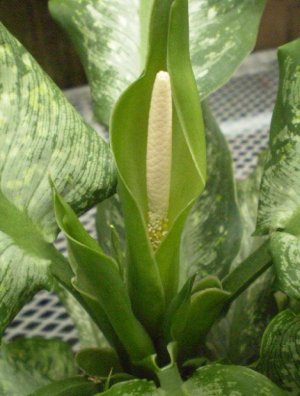
The flower grows rapidly, using the entire reserve of substances necessary for its formation.
Fertilize it in the spring and summer up to three times a month. Fertilizers are applied to choose from: liquid mineral or organic.
By the way, some types of dieffenbachia with white leaves lose this varietal feature, turning into rich green, due to the nitrogen content in complex dressings.
Features of plant transplant
The optimal period for transplanting dieffenbachia at home is February - May. The procedure should be carried out as the root system grows, sometimes even a couple of times a year.
To do this, choose a container with a diameter of several centimeters larger than the previous one.An impressive layer of coal is laid at the bottom for fertilization and drainage, the earthen tuber with the plant is carefully rolled over, damaged roots and adhering drainage residues are removed. Sprinkle on top with fresh slightly acidic soil and watered.
How to prune dieffenbachia
When you already know how to water and how to feed dieffenbachia at home, you need to find out the rules for regularly pruning the plant. Under favorable conditions, the plant releases a new leaf every week, exposing the lower part of the stem. As a result, the indoor beauty loses its decorative effect.
Important! Any part of the dieffenbachia stem is suitable for choosing a sprout for planting. You can spend it at any time of the year, remembering that: the plant is poisonous (in order to avoid the ingress of toxic juice on the skin, all work must be carried out with gloves);
trimming is carried out only with a sharp knife, which is pre-treated with alcohol;
when working with dieffenbachia, you need to protect your eyes so that poison does not splash;
the juice that has emerged is removed by blotting with a soft cloth; for disinfection, the sections are treated with crushed coal;
after work, hands should be washed with soap and water.
 the plant is poisonous (in order to avoid the ingress of toxic juice on the skin, all work must be carried out with gloves);
the plant is poisonous (in order to avoid the ingress of toxic juice on the skin, all work must be carried out with gloves);
trimming is carried out only with a sharp knife, which is pre-treated with alcohol;
when working with dieffenbachia, you need to protect your eyes so that poison does not splash;
the juice that has emerged is removed by blotting with a soft cloth; for disinfection, the sections are treated with crushed coal;
after work, hands should be washed with soap and water.
Important! In stem species of dieffenbachia, once every 3-4 years, the stem is radically cut off, leaving a stump of no more than 10 cm.And in bush species, only damaged and dried leaves are removed.
Where is the best place to place dieffenbachia
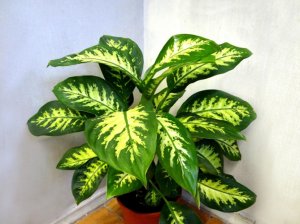
Due to the ability to purify the air from formaldehydes, trichlorethane, xylene and benzene, the flower is recommended to be placed in areas with unfavorable ecology - that is, areas heavily polluted by industrial and automobile exhaust. At home, there is no better place than a kitchen for a flowerpot, especially if its windows overlook a busy road.
If you follow the rules of feng shui, the corner near the desk is perfect. This evergreen inhabitant of the tropics moisturizes the air well, neutralizes microbes, and has a beneficial effect on the nerves. But in addition to the positive qualities, superstitious people say, the plant takes away masculine strength. Therefore, he is feared in the bedrooms.
What kind of lighting does Dieffenbachia need?
Having asked the question of how to grow Dieffenbachia, one should not forget about the peculiarities of the climate of her homeland. A lot of heat, light and moisture is all that a flower needs for full growth in indoor conditions. Moreover, the more spots on the leaves, the more light you give them.
Did you know? Indoor Dieffenbachia from the genus Aroid got its name from the Austrian botanist in honor of the senior gardener of the Vienna Botanical Gardens Josef Dieffenbach.
It is important not to allow direct sunlight, which takes away the brightness of the plant and withers it. At the same time, the light should be diffused
The ideal distance would be a meter or two from the window on the sunny side. If you have the opportunity to additionally organize artificial lighting, the pot can be moved further away.
Temperature regime for the plant
This is the next whim of the fastidious Tropican. He does not tolerate drafts, reacting to them with intense loss of foliage and wilting. In summer, the room where dieffenbachia grows should be from 20 to 30 ° C, and in winter not lower than 15 ° C, otherwise do not be surprised by the sudden yellowing of the leaves.
Also, avoid sudden changes in temperature. especially if you are going to transport a green pet somewhere. In winter, do not place heating appliances next to it. Dieffenbachia loves fresh and humid air.
What air humidity should be for successful growth
Knowing what dieffenbachia likes, it is important to ensure that the humidity in the room does not fall below 65%. Of course, in winter in an apartment where central heating works, it is difficult to maintain such a rate.
To do this, experienced florists recommend spraying and washing the leaves with warm water, the more often the better. Small flowerpots can occasionally have a shower (not cold) by covering the ground in a pot.
Dieffenbachia care at home: watering and lighting
The place for placing dieffenbachia is chosen so as to provide bright lighting without direct sun. In winter, it can grow well in partial shade, away from the window, subject to additional lighting. It is good to place a flower by a window covered with a tulle curtain.
A distinctive feature of the culture is its thermophilicity, the temperature of growing dieffenbachia should not be lower than 18 ° С, in summer it is 18-24 ° С, maximum - up to 30 ° С. In winter, the plant can tolerate a drop to 10-12 ° C for a short time, but this will certainly affect its appearance, causing yellowing of the lower leaves. Optimal for the winter period - 17 ° С, with minimal differences during the day and night. You can not place a flower near heating appliances. Dieffenbachia loves fresh air, in summer it can be on an open balcony or loggia, if it is possible to provide it with shade and no drafts. The culture does not tolerate the latter, it immediately reacts to them with yellowing and falling leaves, so it is better to take the flower out of the room even during airing.
When watering dieffenbachia, certain rules must also be followed. This tropical culture is hygrophilous, but does not tolerate waterlogging, which causes root rot, especially at low temperatures. The earthen lump should be moderately moist, but not wet, watering is carried out with warm, settled water only after the topsoil has dried.
Decorative dieffenbachia in the photo
Like any fast-growing flower, the culture needs regular feeding, during the period of active growth from May to August they are carried out every 10-14 days, in winter and autumn –1 times a month or less. As a fertilizer for dieffenbachia, a weak solution of complex flower fertilizer is used; fertilizing with nitrogen-containing organic matter is also useful. With a lack of nutrients, the plant sheds the lower leaves and exposes the trunk, and also loses its color brightness.
For the successful cultivation of dieffenbachia, home care must necessarily include measures to increase the humidity of the environment. Due to the large surface of the leaf plates, the flower suffers greatly from dry air. The optimum moisture content, at which the plant feels good, is at least 60-70%. Obviously, it is impossible to create such a microclimate in an apartment with central heating, therefore, daily spraying is used to increase the humidity, it is also useful to wipe the leaves with a damp cloth or sponge every 2 weeks. For these procedures, warm boiled water is used, hard tap water causes the appearance of plaque on the sheets and the loss of decorativeness.
When spraying, it is necessary to pay attention to the absence of drafts and the air temperature, otherwise, instead of benefit, you can harm the delicate flower. Even at +18 ° C, it is better to replace spraying with rubbing
The culture develops and grows all year round, requires constant temperatures in summer and winter, however, according to experts in growing dieffenbachia indoor flowers, caring for them in winter should provide plants with a dormant period. At this time, watering and feeding are limited, due to which it is possible to avoid the appearance of small leaves due to insufficient lighting.
It should be noted that for the stem and bush dieffenbachia, the care is practically the same, it differs mainly only in the volume and regularity of pruning, which will be discussed in detail below.
Dieffenbachia: home care
When caring for home, dieffenbachia requires compliance with temperature and light conditions, watering, feeding and protection from pests.
Temperature
Comfortable conditions for a flower in summer are 22-25 degrees, in winter - 16-18 degrees. He is afraid of drafts, in the summer he needs to be put on the balcony - because of his love for clean air. Keeping a flower in direct sunlight is dangerous - it will burn the foliage, and ugly defects will appear on the plates.
Lighting
The Dieffenbachia plant needs bright lighting - only with it it grows quickly and gives beautiful spotty leaf plates. Direct sunlight can cause burns and further illness.
Important! In the absence of a sunny room, you should not worry - the plant belongs to shade-tolerant species
Watering
The shrub requires regular moistening; weekly, dust should be wiped off the foliage using a damp cloth.
Leaves need to be wiped regularly
Spraying
In the spring and summer, the plant is periodically sprayed and given a shower. In order not to provoke excessive moisture, the lower part is covered with plastic wrap before the procedures.
Humidity
Indoor plant grows well at high humidity levels. In connection with this feature, it is necessary to constantly look after it: spray it regularly, and place an aquarium next to the box.
Important! In winter, humidification is increased due to air drying by heating devices
Priming
Flower shops offer a special blend designed for dieffenbachia. If desired, you can make a nutritious soil mixture with your own hands: take 1 part of sand, humus and 3 parts of earth.
Top dressing
Dieffenbachia care involves the introduction of nutrients. Regardless of the variety, the shrub is characterized by rapid growth, which spends a lot of energy. Restorative feeding in the summer months is carried out every 7-10 days. The plant prefers a nitrogenous-organic mixture and special additives designed for variegated species.
Botanical characteristic
Growing an indoor evergreen herb is not too difficult. The plant has thick and straight, rather fleshy stems and large, oblong, glossy or matte alternate leaves. Varieties with green or variegated foliage are well known. Variegated species have an attractive appearance, and the leaves are covered with a pattern represented by light green or yellow specks, stripes and spots. It is thanks to its high decorativeness that the plant is in great demand in room culture.
Particularly popular are Spotted Dieffenbachia and Dissimilar Dieffenbachia, which became the progenitors of a large number of hybrid forms that differ in size and color of leaf plates. The indoor flower is characterized by a fast growth rate. Properly carried out cultivation and creation of comfortable conditions allows the plant to form one new leaf every week. The upper part of the shoot has a growth point, but at home, the height of an adult indoor flower varies within 0.5-2 m. Some varietal varieties have dormant buds, the awakening of which causes the plant to tiller.
The foliage on the stem turns yellow over time, dries up and falls off, which causes the stem to be exposed, and the plant becomes like a palm tree with juicy variegated leaves at the top. With a loss of decorative qualities, the plant needs to be rooted again. Some species require mandatory renewal every three years.
Dieffenbachia blooms in the middle of summer, but in indoor floriculture conditions, the decorative culture rarely acquires flowers. Along with other representatives of the chokeberry family, dieffenbachia flowers are small in size, yellowish-white in color, completely inconspicuous. Then, medium-sized and bright, orange-red berries ripen on the plant. Such a process provokes inhibition of growth and shedding of the lower foliage, therefore, experienced amateur flower growers completely remove the buds.
Transplantation and reproduction of dieffenbachia
Young plants can be transplanted once a year.
In this case, it is important to correctly select the subsequent container. It is recommended to take a flowerpot a couple of centimeters larger than the previous pot
Adult specimens should be disturbed much less frequently and only be transplanted every 4 years.
Dieffenbachia transplant
Transplanting a plant requires care and attention. It is best to act according to a specific algorithm so as not to harm dieffenbachia
- Take a new dieffenbachia pot and place a drainage layer on the bottom.
- Place a small amount of soil on top.
- Remove the plant from the pot and examine its roots carefully. If defects are found on the roots, then it is best to cut them off. The cut areas will need to be treated with activated charcoal.
- Without shaking off the ground, you need to move the dieffenbachia to a new pot.
- Cover the sides with soil and water the flower.
When the plant has reached a large size, then you should not send it to a new, deeper container. It will be enough to renew the topsoil.
In order to learn how to propagate dieffenbachia at home, you need to study 4 different ways:
Seeds. This method is used by breeders to develop new varieties. The seeds are obtained by manually pollinating male and female flowers.
Cuttings of the tops. When the plant is stretched up, and the stem has no leaves, then the top is cut off. It is placed in water or peat-sand mixture. It is recommended to spray the stalk during the growth process and protect it from direct rays.
Stem pieces. The pieces are cut into several cuttings up to 20 cm in length. They dry for 2 days, and then fit into a substrate of sand and peat. After that, the container is covered with a film and remains at a temperature of +25 degrees for 6 months.
Propagation of dieffenbachia by pieces of the stem
Layers. A cut is made on the stalk and wrapped with foil. All this is fixed with tape or thread, and after that it will be possible to observe the appearance of roots, which are cut off and planted in a separate pot.
Plant care
Caring for dieffenbachia at home includes elementary agrotechnical measures: watering, pruning, feeding and transplanting.
Watering and feeding
You need to start with the quality of the water. Boiled or settled water should be used not only for watering, but also for spraying and wiping the flower. Hard water can cause the tips of the sheets to drill and fall off. Oxalic acid will help soften the water. Cool rainwater can be used. If you want to shower the plant, then the water should be slightly warm and not get into the ground. Dieffenbachia should be watered regularly, and in summer it is also abundant. The soil should not dry out, but the swamp is not welcome. Winter watering should be more modest, the quality of the soil can be considered a benchmark. In summer, the flowerpot is watered several times a week, in winter, as a rule, one is enough. Since there is no clearly defined dormant period in the flower, it can be fed all year round, taking into account the fact that in spring and summer, fertilizing needs to be applied more often, and they should be more varied.
During the active phase of the growing season, the plant is fertilized twice a month, in winter - once every one and a half months. Of course, special complex fertilizers are best suited, but others can also be used, as long as they do not contain lime.The best option would be a liquid top dressing with mineral and organic nitrogen-containing elements. Nitrogen is not suitable only for varieties with white leaves.
Trimming and shaping
Dieffenbachia, like any other actively growing plant, needs formative pruning, otherwise, soon, instead of a neat bush flowerpot (size does not matter), you will have a neglected leafy riot.
Even the smallest and tidiest bush needs to be updated. And there is no need to remind you that you need to cut off a dried or damaged leaf. Before you start pruning or just want to shorten a little, take care of your safety.
Pruning dieffenbachia is not difficult, but it is important to know how to properly and safely. Damaged sheets must first be soaked to prevent the poisonous juice from getting into the eyes or on the skin (it is recommended to use medical gloves for work)
The pruning knife must be sharp and decontaminated. The sheet is then cut off completely, if necessary with part of the trunk. The cuts are also blotted and sprinkled with crushed charcoal.
The plant is transplanted almost annually, the need depends on the growth rate. The signal for the need for the procedure is that the pot becomes cramped for the roots. A bush is transplanted in late winter or early spring, a plant transplanted in summer may not take root. Since the roots of the flower are fragile and brittle, it is better to transplant by the transshipment method, together with an earthen lump. In a new container, slightly larger (slightly), you need to place a new drain.
Only old bare plants need pruning. The substrate can be bought ready-made or prepared by yourself. This will require sheet soil, peat, humus, sand and birch charcoal, which will cleanse the soil of excess salt. At first, a growth stimulator is added to watering.
Reproduction
There are several ways of plant propagation: apical cuttings, stem and air cuttings. Propagation by cuttings is the most popular method. For this, the cut off bare parts are soaked and placed in any nutrient medium (water, moss, peat). The temperature should be moderate, about +22 ° C, the plant should not be exposed to direct sunlight. You also need to take care of spraying. When the roots have grown a few centimeters, they can be planted.
Possible growing problems and diseases
Violation of the requirements for the care of an ornamental tree often leads to the development of diseases. Sometimes the problem is related to pest attacks. It is immediately clear what a sick dieffenbachia looks like: all manifestations are reflected in the foliage.
In a diseased flower, the leaves are usually damaged.
Drops buds and leaves
If the bush is actively getting rid of foliage, then the phenomenon is associated with rot. It is triggered by excessive moisture. You can check the assumption by the state of the soil mixture: even with rare or absent moisture, it does not completely dry out. Treatment consists in the step-by-step cutting of the affected root system and sprinkling of the cut sites with activated carbon.
Leaves turn pale
The blanching of usually bright and colorful foliage is due to direct sunlight. The flower must be rearranged in partial shade, all affected leaf plates must be cut off - they cannot be restored.
The tips of the leaves dry
Drying of the tips of the plates is the first alarm bell, which may be followed by a massive drying out of the foliage. If a feature appeared in an adult plant, then the processes of natural aging are attributed to the reasons. In cases where the entire flower has begun to dry, the source of the problem may be:
- insufficient spraying and moisture;
- increased dryness of the air;
- hot weather.
Important! Ignoring the problem of artificial drought often ends in the death of the flower
The lower leaves fall
Rapid growth leads to yellowing and shedding of foliage in the lower layer.
Attention! If a leaf discharge affects the entire plant, then it tries to report drafts or too low a room temperature.
Pests
The main problem of the shrub is the attacks of spider mites, mealybugs, scale insects and aphids. What is the main sign of an attack: the leaves begin to turn yellow, become covered with extraneous bloom. A small number of pests are removed with a wet sponge, which is pre-moistened in soapy water. In other cases, it is necessary to use special preparations sold in flower shops.
Other problems
Decay of the root system is associated with an excess of incoming fluid, lack or insufficient drainage. Rotten areas must be cut off, and in case of a complex lesion, the upper part is separated from the plant and rooted. The lower share is discarded.
Caring for a dieffenbachia flower at home is not considered difficult. Compliance with the requirements for watering, temperature and illumination will help you constantly admire the decorative flower, and not deal with its treatment.
vote
Article Rating
Reproduction technology at home
To understand how dieffenbachia reproduces, you need to know that the vegetative method involves the use of:
- cuttings;
- leaves;
- tops;
- stems;
- shoots;
- roots.
As a neighbor for dieffenbachia, large-root alocasia is well suited.
Cuttings
Young parts of the stem of a light green color 10 cm long are used as cuttings. They take root either in water or in a substrate.
When using water for rooting, a part of the cutting is placed in it.
The water is disinfected with activated carbon, and to stimulate the rooting process, it is useful to enrich the liquid with a few drops of aloe juice. To avoid decay of the cutting, the water should be replaced with fresh water every week.
After about half a month, the first roots will appear on the handle. When they reach a length of 2 cm, the cuttings are planted in the ground, deepening them by 2-3 cm.

To successfully root cuttings directly in the soil, you should:
- Prepare a quality stalk.
- Dry it within 24 hours.
- For 7-9 hours, immerse it in a stimulating solution (for example, in "Kornevin").
- Plant the cutting into the soil to a depth of 5 cm.
- If the ambient air is cool, cover the container with the handle with a transparent film to create a greenhouse effect.
Sheet
This method of plant propagation involves the following actions:
- Choose a quality leaf on the plant with an intact surface and bright color.
- Cut it off and dry it for 24 hours.
- Place in a container with water.
- When root shoots (2 cm long) are formed, the leaf is planted in prepared soil.
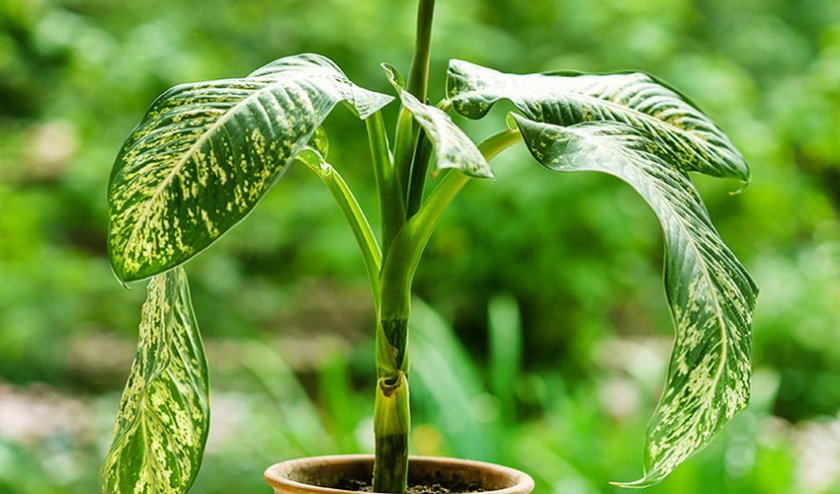
Top
It is also a cutting, but cut from the top of the bush just below the last bud. This method of propagation of dieffenbachia allows you to quickly get an adult plant with all its decorative advantages. However, the old plant can no longer be preserved.
Therefore, this method is used mainly in cases where the plant has lost its lower leaves with age, or root decay is found. Sometimes in this way it is possible to save a bush affected by diseases.
In order for reproduction by the tip to give a good result, you need:
- Gently cut off the top of the bush below the top bud.
- Immerse the bottom piece of the top in a container with water enriched with activated carbon.
- Heat the water at an ambient temperature below +22 ° C.
- Replace the old water weekly with fresh water.
- When the roots are 3 cm long, plant the sprouted tip in the prepared soil.
Stem
This method is predominantly rejuvenating in nature and is used when the leaves begin to fall, exposing the lower part of the trunk, and the leaves on the middle "floor" of the plant turn yellow. To root the stem, it is necessary to find the growth point from where the leaves begin to diverge. The stem is cut 7 cm below this place.
Did you know? Designers say that the coloring of the leaves of different varieties of Dipenbachia is so diverse and original that these plants are suitable for decorating any room, decorated in a variety of styles.
Then you need to:
- Dry the cut off stem (about a day).
- Dig it in the prepared soil.
- Create greenhouse conditions with transparent film.
- Wait for the stem to germinate (it does not germinate immediately, sometimes you have to wait six months).

Shoots
This method of reproduction is beneficial in that the whole plant is rejuvenated in parallel. Side young shoots that interfere with its development are removed and at the same time used for flower propagation.
For this you need:
- Cut off the shoot with a couple of young leaves.
- Put it in a container with water pre-enriched with activated carbon.
- Changing the water weekly, wait for the germination of root shoots (they should be 2-3 cm long).
- Plant the seedling in the prepared soil, bearing in mind that the sprouted shoot is almost a full-fledged plant.
By dividing the roots
Since dieffenbachia feels equally uncomfortable both in an excessively spacious container and in a cramped one, its next transplant can be combined with reproduction through root division.
To this end:
- A bush with an earthen clod is released from the container.
- The roots are washed in running water, while unweaving them.
- If root processes damaged by rot are found, they are cut off, and the rest are treated with a low-concentration solution of manganese or water with activated carbon.
- Leave the root ball divided into several parts for a day to dry.
- Plant the shoots in the prepared soil.

Popular types
The popularity of this decorative flower culture is directly related to its luxurious appearance. Large leaves with typical bright yellow, greenish stripes and spots can transform the most ordinary-looking room. Any type of dieffenbachia looks great in a home environment or in the interior of a public institution. And, most importantly, they do not require special care.
Each of the species of this tropical plant (and there are more than 40) has a significant difference in color and has a unique beauty. But still, its brightest representatives received greater recognition and prevalence:
- Dieffenbachia Oerstedii (Dieffenbachia oerstedii) is a culture with a dense, evenly colored crown. Its distinctive feature is slightly elongated, pointed leaves with a uniform green color and a wide central vein.
- Dieffenbachia seguine has a characteristic greenish stalk with white blotches all over the base. Large oblong leaves, slightly rounded at the base.
- Dieffenbachia bausei is one of the most popular shrubs with a strong tree trunk. Even with normal care, it grows 1 m in height, and the wide light green leaves have a characteristic "marble" ornament.
- Dieffenbachia maculata is the queen of the tropics. On its dense, well-developed trunk, a luxurious crown is neatly located - the main trump card of this flower culture. Skillfully decorated by nature itself, it frames the stem with a beautiful cascade and gives it a luxurious, majestic look. In a well-lit, humid place and with proper care, it reaches the climax of its decorative effect.
Propagation of dieffenbachia by cuttings
When indoor plant lovers talk about such a flower as dieffenbachia, they remember reproduction by cuttings first of all. The fact is that this method gives the best survival rates.
For this method, you need to prepare cuttings from the stem. It is short in dieffenbachia, but very dense and thick
It is necessary to separate the shoot 5-8 centimeters long from the main bush with an oblique cut.It is very important to leave at least 3 dormant buds on each stem cut (they look like small arc patterns)
All cuts and other mechanical damage must be treated with strong root-forming stimulants - most often flower growers prefer Kornevin.
It is necessary to deepen the cuttings into the substrate by 3-4 centimeters. Then moisten the ground and cover the container with a glass or plastic dome. A month later, you can transplant it into a separate pot.
The apical cutting should be much larger than the normal stem
Propagation by apical cuttings
Dieffenbachia propagation by the top of the bush is carried out with the aim of renewal and rejuvenation. Cut off 15-25 centimeters of the stem along with the leaves and process the cuts with charcoal.
After that, the stem cutting is placed in water or a moistened nutrient soil mixture. After 3 weeks, it will already be fully rooted.


